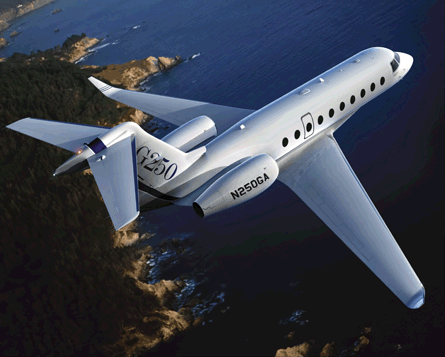Despite cutbacks of 1,200 employees and planned furloughs this summer to account for diminished order intake, Gulfstream is surging forward in the developmental regime. Highlights this year willinclude first flights of the new G250 super-midsize and G650 long-range jets, says president Joe Lombardo.
According to Lombardo at this morning's press conference, the reduced demand has required the Savannah, Georgia-based airframer to cut its 2009 production estimates for midsize and large-cabin jets by 20% to 97 aircraft, down from the 126 expected last year. Despite the softening, the company continues to maintain a healthy backlog of more than $20 billion, down by around $2 billion from the end of 2008, says Lombardo.
 |
|---|
© Gulfstream |
Progress on the $24 million G250, being co-developed with Israeli AerospaceIndustries as a replacement for the G200, includes completion of the first fuselage by IAI and first wing assembly by Spirit AeroSystems. In addition, landing gear drop tests, the development team has also accomplished first power-on of the aircraft and static test articles of the major assemblies have been fabricated for the certification programme.
Entry into service is expected in 2011. The G250 is powered by two Honeywell HTF7250G turbofans and has Rockwell Collins' new Fusion integrated avionics suite in the cockpit.
For the $60 million G650, also setfor first flight this year, Lombardo says the first Gulfstream-built fuselage is assembled as well as the first Spirit-built wing. Additionally, the first Rolls-Royce BR725 turbofan engines have been podded, says Lombardo. Progress on the aircraft's systems, including its Honeywell PlaneView II avionics, as well as engine development gives the company confidence in a first flight this year.
Incentive to achieve first flight this year is significant as the first 50 customers will be required to submit additional deposit money at that point. Entry into service is expected in 2012.
Gulfstream continues to perform research on a variety of advanced topics, including technologies required to build a supersonic business jet. For its subsonic line, the focus areas include synthetic and enhanced vision, advanced cabin systems, aircraft health and trend monitoring and advanced flight controls, including fly-by-light and fly-by-wireless.
For its supersonic efforts, sonic boom mitigation methods are among the highest priorities, says Lombardo. However, Gulfstream has saidunequivocally that it will not launch a supersonic business jet programme until there is consensus among aviation authorities globally as to what would be acceptable noise and pressure levels for over-land supersonic flight, a practice prohibited in the USA by Federal Aviation Administration rules.
The company says it has received queries from other manufacturers possibly interested in licensing the company's patented "quiet spike" technology thatdampens supersonic noise by extending a spike from the aircraft's nose during cruise.
Source: Flight Daily News



















